Notes on Kinematics – One Dimensional Motion and Projectile
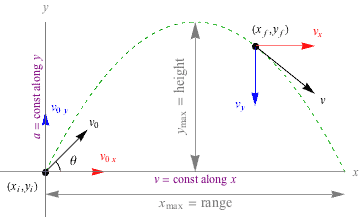
Notes on Kinematics – One Dimensional Motion and Projectile
This note summarizes everything you need to know on kinematics in a simple way. It os brief and concise.
Definition of terms
Displacement: It is the distance moved in a particular direction. It is a vector quantity. The S.I unit is (m)
Velocity: It is the rate of change of displacement. It is a vector quantity. The S.I unit is (ms-1)
Speed : It is the rate of change of distance. It is a scalar quantity. The S.I unit is (ms-1)
Acceleration: It is the rate of change of velocity. It is a vector quanity. The S.I unit is (ms-2)
Uniform Speed: This is equal distance at equal time interval
Graphical representation of Uniform Speed

Uniform Acceleration: This is equal velocity at equal time interval
Graphical representation of uniform acceleration
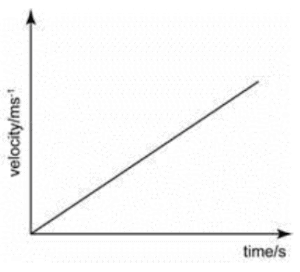
Mathematical Expressions
speed = distance/ time = d / t
velocity = displacement / time = d / t
Average speed : Total distance/ total time taken
Acceleration = change of velocity / time = (v – u) / t
v = Final velocity
u = initial velocity
Velocity – time Graph
The area under the graph of a velocity – time graph is displacement
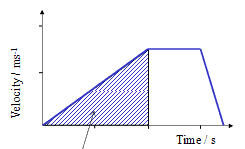
Since the diagram is a trapezium, we can calculate the total distance using the area of a trapezium
Let look at an example
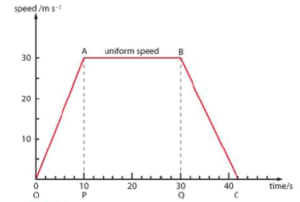
From the diagram above
i what is the distance travelled during the first 10s
ii the total distance travelled
iii the average speed for the whole journey
Solution
i using triange AOP = 1/2 * OP * AP = 1/2 * b * h = 1/2 * 10*30 = 150m
ii using Trapezium AOCBA = 1/2 *(AB + OC) * AP = 1/2 *(20 + 42) *30 = 1/2 * 62 *30 = 930m
ii average speed = total distance / total time taken
total time taken is 42s
average speed = 930 / 42 = 22.1 ms-1
Derive, from the definitions of velocity and acceleration, equations that represent uniformly accelerated motion in a straight line
v =u+at
s=[(u+v)/2]t
v2=u2+2as
s=ut+1/2at2
v = final velocity
u = initial velocity
t = time taken
s = distance covered
a = uniform acceleration
From the definition of acceleration
a = (v-u) / t
Cross multiply and rearrange
v = u + at
From average velocity,
Average velocity = s / t
Average velocity = (v +u)/2
equate the two equations together, you get
s / t = (v +u)/2
Cross multiply and rearrange
s = [(v + u)t]/2
Taking v = u + at ………i , and s = [(v + u)t]/2….ii
Substiturte v = u + at in eqn i into eqn ii, so you get,
s = ut + 1/2at2
Taking v = u + at…….i and s = [(v – u)t]/2…. ii
Make t the subject of the eqn in eqn i
t = (v – u) / a …………iii
substitute eqn iii into eqn ii, you get
v2=u2+2as
Motion of bodies falling in a uniform gravitational field without air resistance – Kinematics

In a uniform gravitational field, the gravitational field strenght is constant. The gravitational field strenght is also refer to as acceleration due to gravity (g).
Without air resistance means the air resistance is negligible or the drag force
The displacement – time graph, velocity – time graph, acceleration – time graph of such a motion is shown below

Always remember that the gradient or slope of displacement – time graph is velocity, the gradient of velocity-time graph is acceleration.
From the graph above, the acceleration-time graph shows that it is a uniform acceleration or a constant acceleration.
v =u+at
s=[(u+v)/2]t
v2=u2+2as
s=ut+1/2at2
in this case all you have to do is make a = 9.81ms-2, which the value of acceleration due to gravity. But in some cases you can be ask to make a = 10ms-2
The motion of bodies falling in a uniform gravitational field with air resistance
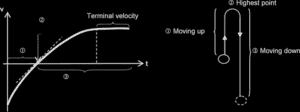
When any object moves through air, the air offers a frictional resistance (drag) to the motion. This causes the object to decelerate. The deceleration is not constant but depends on the velocity of the object. The faster the object the greater the resistance and deceleration. You can experience this when you run – the faster you run, the harder the air seems to blow against.
Graphical representaion of this kind on motion is shown below
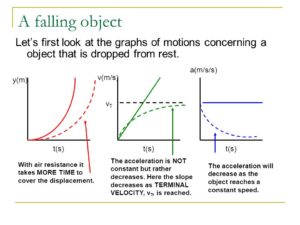
Where the arrow pointed shows the graph of displacement-time graph, velocity-time graph, acceleration-time graph when there is air resistance.
For displacement-time graph: it takes more time to cover because of the air resistance compared with when there is no air resistance
For velocity: the acceleration isnt constant because as the speed increases the air resistance increases until a time is reached when the the weight of the object equals the drag force(air resistance), at this point no resultant force acting on the body and it will fall with a constant speed, called the terminal velocity(this has being explained when i discussed dynamics)
Terminal velocity is the point at which the resultant force is zero.
Motion due to a uniform velocity in one direction and a uniform acceleration in a perpendicular direction.
The type of motion to discuss here is a Projectile. Projectile is any object that is given an initial velocity and then follows a path determined entirely by gravitational acceleration.
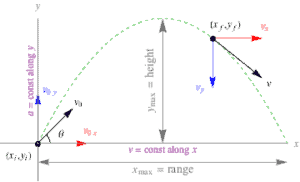
The initial velocity is at an angle of θ. This initial velocity will be resolve into both vertical component and horizontal component.
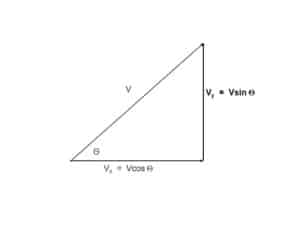
Using your SOHCAHTOA
the vertical component of the velocity will be usinθ
the horizontal component of the velocity will be ucosθ
horizontal component of the velocity has no force acting so it is constant
vertical component of the velocity has a constant force acting so there is a constant acceleration.
derivations
To calculate the time to reach the maximum height
v = u – at
at maximum height v = 0
0 = usinθ – at
t = usinθ / a
your a = 9.81ms-2
Time of flight = 2*t = 2usinθ / a
To calculate maximum height
v2=u2 – 2as
at maximum height v = 0
u = usinθ
a = 9.81ms-2
s = maximum height
if you subsitute you get your maximum height
Horizontal distance (range)
v = d / t
the reason for this formula is because there is no force acting on it, which implies a uniform velocity
d= horizontal distance
v = horizontal component of velocity = ucosθ
t = time to complete the parabolic path ( which can be sometimes time of flight or time to reach the maximum height depending on the projectile diagram given). if it is a full diagram you use time of flight. if it is half of the full diagram you use time to reach the maximum height). The diagram above is a full diagram.
ucosθ = d / t
Recommended: Solved questions on motion
